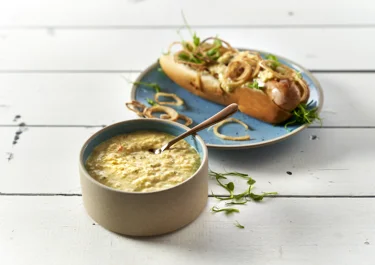
Remoulade

Instructions
Pickled vegetables
Brine
Pickles
Mayonnaise
Remoulade
FAQ: Questions about remoulade
Our helpful answers to the most common questions will help you learn the finer points of remoulade.
Ingredients
Pickled vegetables
Water | ½ l |
|---|---|
Coarse salt | 1 tsp |
Carrots, peeled and sliced | 2 |
Cauliflower, in small florets | ½ |
Green courgette, in small cubes | ½ |
Brine
White wine vinegar | 200 ml |
|---|---|
Sugar | 4 tbsp |
Coarse salt | 1 tsp |
Black peppercorns | 8 |
Ground turmeric | 2 tsp |
Corn flour | 2 tsp |
Water | 2 tbsp |
Sodium benzoic | 1 tsp |
Mayonnaise
Egg yolks | 2 |
|---|---|
Fine salt | ¼ tsp |
Lemon juice, freshly squeezed | ½ tsp |
Unflavoured oil | 150 ml |
Tips: Get the best remoulade
Explore a few of our tips to help you make the best remoulade.
Uniform vegetable slicing
Ensure that your vegetables are cut into uniform pieces. This ensures even pickling and a consistent texture throughout the sauce.
Room temperature ingredients
Ensure the egg yolks and oil are at room temperature before starting. This helps emulsify the mayonnaise.
Adjust the texture
If your remoulade is too thick, thin it with a bit of water or lemon juice. If it is too thin, add more chopped pickles or cornflour to thicken it. Make these changes slowly, stirring well after each addition, to get a consistent texture.
Swap sodium benzoate for boiled water and thoroughly washed hands
It is possible to leave out the sodium benzoate without compromising the quality and shelf life of our remoulade. Make sure that you wash your hands thoroughly throughout all the processes and pour boiling water into the container to eliminate any bacteria. In doing so, the vinegar should be enough to prevent any mould from growing.
Try our delicious remoulade recipe
Remoulade is a great condiment to have in the fridge, and now you can whip up a batch anytime. While the recipe has a few steps, it is essentially simple and easy to prepare. Remoulade offers a perfect balance of acidity, sweetness, earthiness, and creaminess, allowing you to enjoy it with a wide range of dishes.
Explore more tasty recipes, such as our easy pico de gallo and a quick hollandaise sauce. You can also pair remoulade with classic schnitzel.
Tangy pickled vegetables
The pickled vegetables play an essential part in making the remoulade. Soaking carrots, cauliflower, and courgette in a brine of turmeric, sugar, and white wine vinegar creates a delightful blend of sweet, earthy, and slightly sour flavours. The tanginess is key to balancing the rich creaminess of the mayonnaise. With the addition of black peppercorns, the pickled vegetables receive a subtle hint of spice that helps round out the overall taste. By pickling your own vegetables, you can ensure that your remoulade captures all the right nuances and flavours.
Mixed with creamy and rich mayonnaise
Our recipe includes homemade mayonnaise made from egg yolks, oil, and freshly squeezed lemon juice. Whisked together, the mixture emulsifies and turns into the creamy base we desire. The result is a rich, velvety-smooth mayonnaise that is perfectly paired with tangy and slightly sweet pickled vegetables.
How to serve remoulade?
Remoulade is an incredibly versatile condiment that pairs up nicely with various dishes. Our version is also a popular choice for fried foods like deep-fried fish, fish fingers, and calamari. The creamy sauce provides a beautiful counterpoint to the crispy batter and tender fish. Similarly, deep-fried cauliflower, courgette fries, sweet potato fries, or regular fries are also great dippers for the creamy condiment.
Try different variations of remoulade
If you are looking for a fresher version, try adding dill, parsley, or tarragon. They bring an aromatic touch to the rich and tangy sauce. You can also experiment with a dash of curry or a splash of hot sauce for sharper nuances.
Consider trying your hand at regional versions, like French remoulade or Louisiana-style remoulade. French remoulade has its roots in the French culinary tradition and is more refined than the Danish version. It typically contains mayonnaise and a variation of mixed herbs, cornichons, capers, and Dijon mustard. French remoulade is often served with cold cuts, pâté, meats, and seafood like shrimp and poached fish.
Louisiana-style remoulade is quite different. This version embraces its Creole and Cajun origins and offers a spicy kick. It typically blends bold spices like paprika and cayenne pepper, which also colour the sauce more red than yellow. Combined with Dijon mustard, Worcestershire sauce, and hot sauce, Louisiana-style remoulade is particularly well-suited for seafood, where its bold kick can complement deep-fried and grilled dishes.










